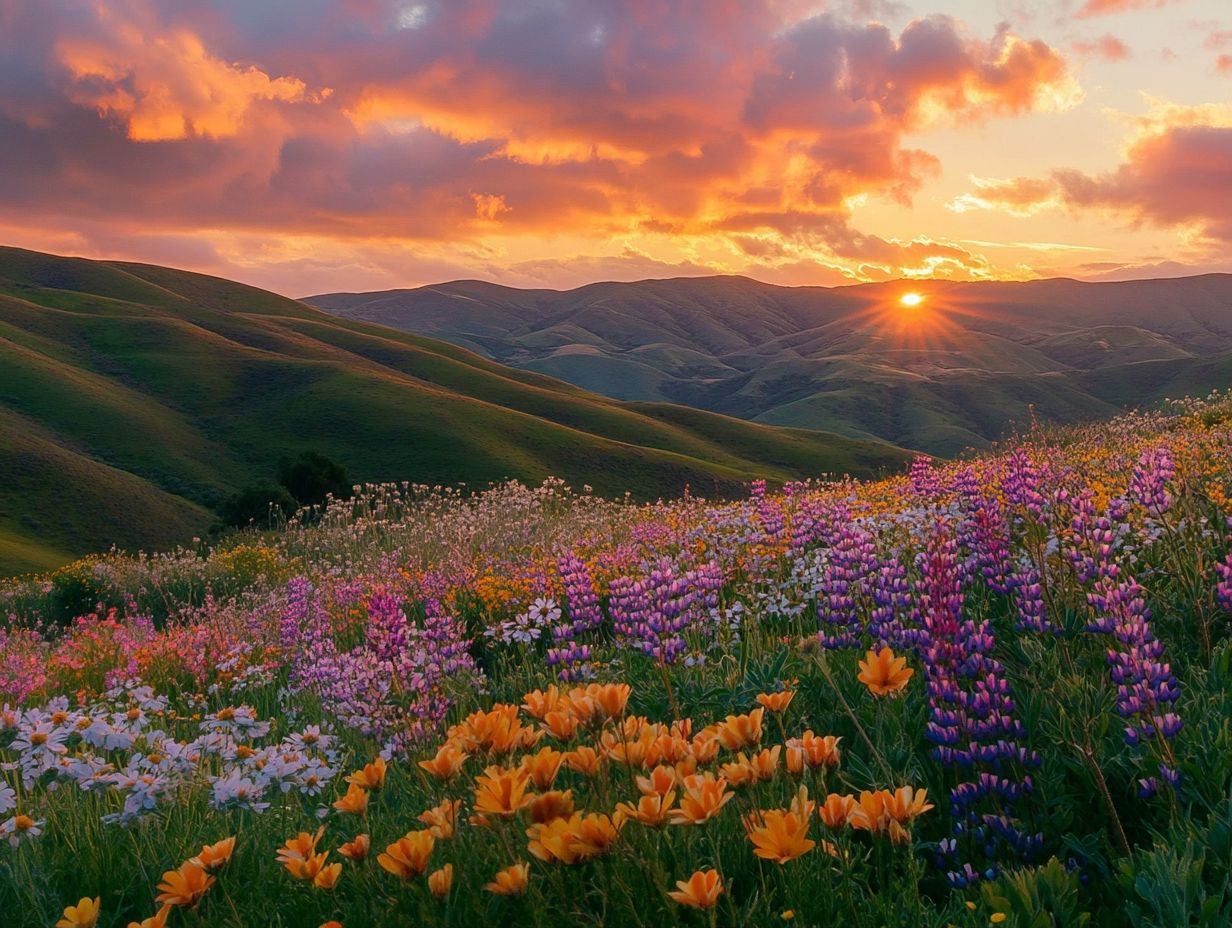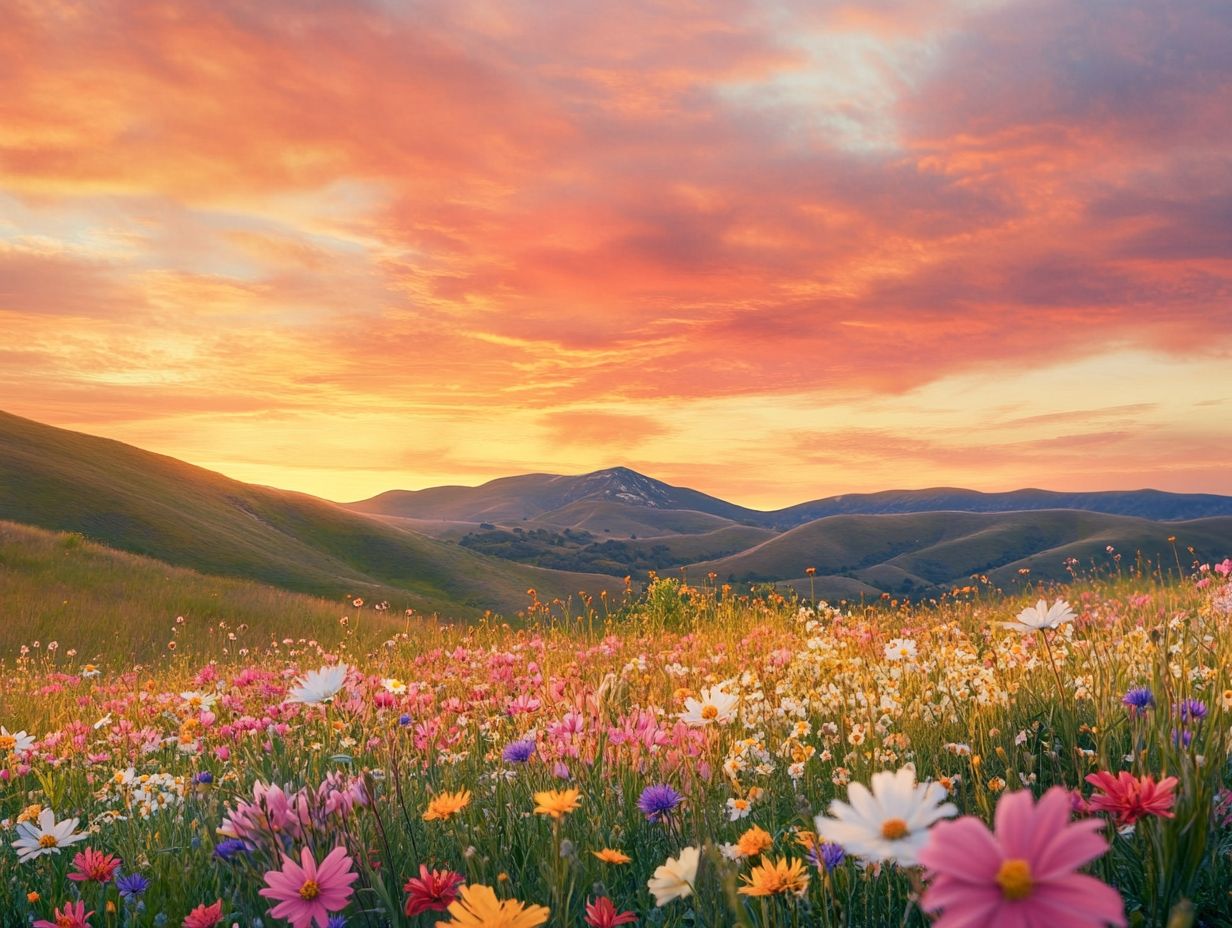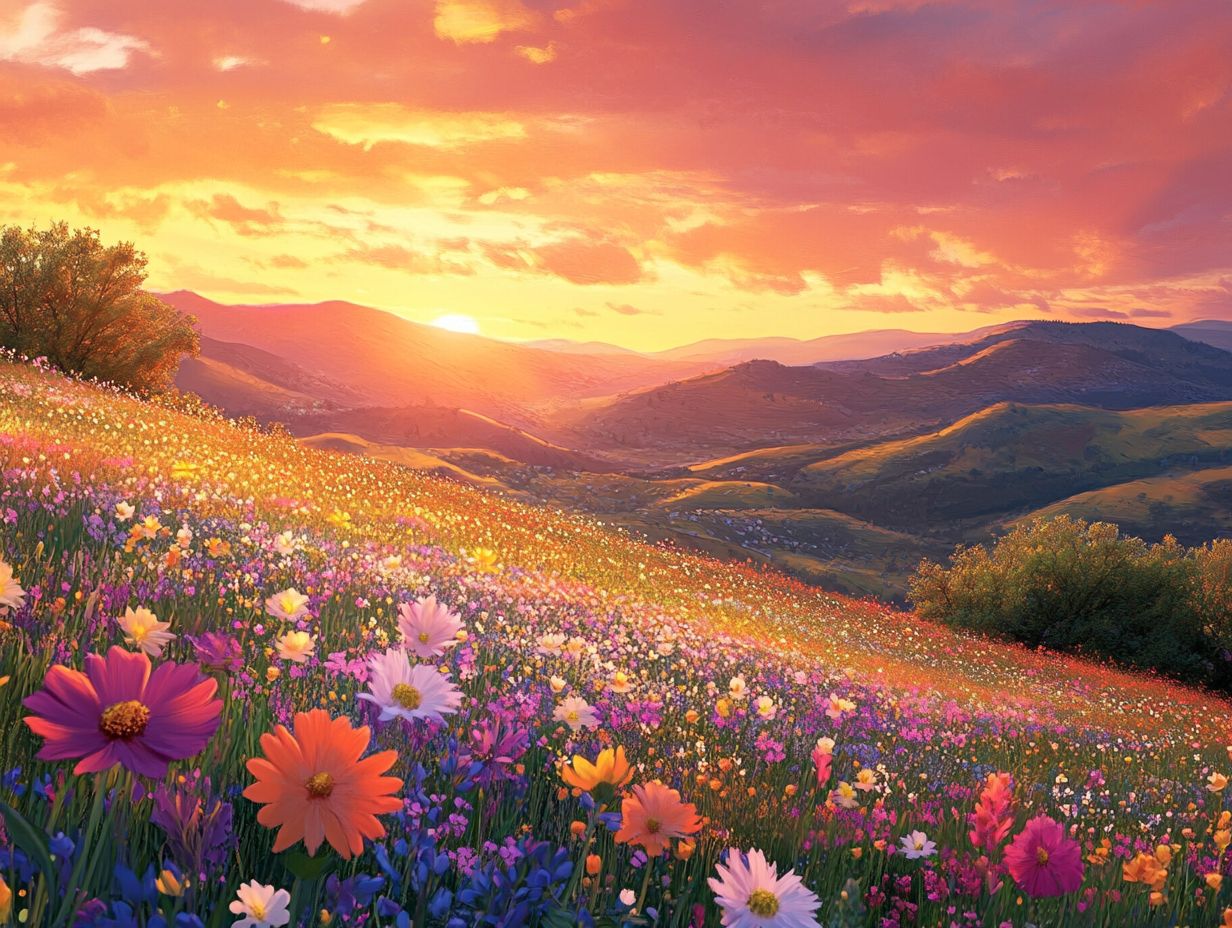Choosing the appropriate color temperature for your landscape has the potential to transform your outdoor space into a visually captivating environment.
This article will examine the concept of color temperature, the various factors to consider—including light sources and surrounding environments—and the different types available, ranging from warm white to daylight.
Practical recommendations will be provided for selecting the ideal hue to enhance both the aesthetics and functionality of your landscape.
We invite you to engage with us as we navigate the principles of color temperature in landscaping, ensuring that your outdoor area achieves its optimal appearance.
Understanding Color Temperature

Understanding color temperature is essential for effective lighting design, as it profoundly impacts the ambiance and aesthetic appeal of outdoor spaces, including gardens and pathways. Measured in Kelvin (K), color temperature dictates the hue of light and its psychological effects, from warm light that fosters a cozy atmosphere to cool light that improves visibility.
The incorporation of LED lighting with varying color temperatures can further optimize energy efficiency and sustainability within landscape architecture. By comprehending the concepts of warmth and coolness in light sources, designers can create harmonious outdoor environments that align with user preferences and enhance the nighttime ambiance.
What is Color Temperature?
Color temperature refers to the characteristic appearance of light emitted from a light source, measured in degrees Kelvin (K), which indicates whether the light appears warm or cool.
Understanding this concept is essential for various lighting applications, as different color temperatures can significantly affect mood and perception.
Warm white light, typically ranging from 2700K to 3000K, fosters a cozy atmosphere often associated with relaxation, making it ideal for residential spaces and restaurants. In contrast, bright white light, approximately 3500K to 4100K, promotes alertness and productivity, rendering it a preferred choice for professional work environments.
Daylight options, which range from 5000K to 6500K, closely replicate natural sunlight and are recognized for their ability to enhance concentration and mood.
By carefully selecting the appropriate color temperature, individuals can make informed decisions that influence psychological effects and the overall ambiance of a space.
Factors to Consider when Choosing Color Temperature
When selecting the appropriate color temperature for outdoor lighting, it is essential to consider several factors. These include the specific light sources utilized and the characteristics of the surrounding environment, as both can significantly influence illumination levels and visual harmony.
Light Source

The selection of light sources plays a critical role in determining the overall color temperature and quality of illumination. LED lighting has gained considerable popularity due to its energy efficiency and versatility in color rendering.
Traditional incandescent bulbs emit a warm glow with a lower color temperature, making them particularly suitable for creating inviting atmospheres. In contrast, fluorescent lights produce a cooler, bluish light that is often preferred in commercial settings.
As sustainability becomes an increasingly important consideration, many individuals and organizations are opting for LED lighting, not only for its extended lifespan but also for its capacity to offer a range of color temperatures that can enhance color contrast across various environments.
By employing these different types of lighting, both individuals and businesses can achieve aesthetic appeal while simultaneously minimizing their environmental impact.
Location and Surrounding Environment
The location and surrounding environment are critical factors in determining the appropriate color temperature for outdoor lighting. Different settings necessitate varying levels of light intensity and color balance to enhance visual interest and ensure safety.
Along with these fundamental considerations, architectural features—ranging from contemporary structures to traditional designs—significantly influence the selection of color hues. The interaction of color with materials such as wood and stone can produce either harmonious contrasts or bold statements.
Furthermore, deliberate choices in landscaping, often informed by seasonal variations, contribute additional layers of vibrancy and context. For example, the rich tones of autumn may suggest a preference for warmer light palettes, whereas the bright blooms of spring could inspire cooler, more refreshing selections.
Cultural influences further enrich this color palette, reflecting the identity and purpose of the space, thereby ensuring that aesthetic decisions align seamlessly with functional outdoor requirements.
Types of Color Temperature
Color temperature can be classified into several categories, primarily warm white, cool white, and daylight options. Each category provides a unique visual experience and fulfills specific lighting requirements in outdoor environments.
Warm White

Warm white lighting, with a color temperature ranging from approximately 2700K to 3000K, establishes a cozy and inviting ambiance that is particularly well-suited for enhancing outdoor seating areas and garden pathways.
This type of illumination not only fosters relaxation but also significantly improves mood, making social gatherings feel more intimate and enjoyable, enhancing their overall user experience. The gentle glow emitted by warm white light cultivates a sense of safety and tranquility, which is especially advantageous in outdoor environments where natural light may be insufficient.
By implementing light diffusion techniques, these fixtures can create soft shadows and minimize glare, thereby enhancing the aesthetic appeal of garden features and patio furniture. Consequently, the application of this lighting approach can transform ordinary outdoor spaces into enchanting retreats where form and function coexist harmoniously.
Cool White
Cool white lighting, typically ranging from 3100K to 4500K, offers enhanced light intensity and visibility, making it particularly suitable for areas that require task lighting and security measures in outdoor settings.
This type of illumination not only improves visibility during late-night outdoor activities, such as barbecuing or gardening, but it also significantly enhances safety around walkways and entry points. By ensuring well-lit environments, these lighting solutions help deter potential hazards and unwanted intrusions, thereby contributing to a more secure outdoor space.
Cool white lighting is especially effective for illuminating outdoor sports facilities, parking lots, and residential areas, where high functionality and clear visibility are essential. Its crisp, bright quality aids in distinguishing colors and details, optimizing both usability and comfort during evening gatherings or late-night strolls.
Daylight
Daylight color temperature, typically ranging from 5000K to 6500K, emulates the characteristics of natural light and is frequently employed to enhance the aesthetic appeal of outdoor features while fostering an energetic and vibrant atmosphere.
By incorporating this temperature range into architectural and landscape lighting designs, one can achieve a harmonious balance of brightness and warmth that accentuates the textures, colors, and shapes present in outdoor environments. This strategic lighting approach not only highlights significant architectural elements such as facades and sculptures but also emphasizes the lushness of greenery and the intricate details of garden pathways.
Utilizing daylight color temperature has the potential to transform evenings into enchanting experiences, as it creates a welcome ambiance that encourages individuals to explore and enjoy their surroundings after sunset.
Choosing the Right Color Temperature for Your Landscape

Selecting the appropriate color temperature for outdoor landscapes requires a comprehensive understanding of the distinct characteristics of the spaces involved. It is essential to consider user preferences and the intended purpose of the lighting fixtures in order to achieve optimal results.
Tips and Tricks
When selecting color temperatures, it is advisable to utilize techniques such as color matching with seasonal flowers and implementing light layering strategies to create depth and interest in landscape design. This method not only enhances visual appeal but also ensures that the environment remains inviting during evening hours.
It is essential to pay close attention to the direction of light, as it plays a critical role in shaping the overall ambiance. For example, angled lighting can effectively accentuate the textures and forms of plants. Additionally, incorporating well-placed shadows can introduce an element of drama, thereby enlivening your landscape maintenance efforts.
By strategically positioning lighting fixtures, one can highlight pathways, garden features, and architectural elements, thereby maximizing the aesthetic value of outdoor spaces.
Benefits of Choosing the Right Color Temperature
Selecting the appropriate color temperature for outdoor lighting presents numerous advantages, including improved aesthetics and enhanced functionality.
This choice can significantly transform outdoor spaces into welcome environments that encourage social interaction and facilitate outdoor activities.
Enhanced Aesthetics
The strategic use of appropriate color temperatures can significantly enhance the aesthetics of outdoor spaces by creating visual interest and effective color contrast that emphasizes landscaping elements.
By carefully positioning lighting fixtures around pathways, garden features, and seating areas, one can effectively highlight the most attractive aspects of a garden. For instance, employing warm white lights can illuminate striking trees or blooming flowers, providing a cozy ambiance while enhancing their textures and colors.
Current trends in outdoor lighting, such as solar-powered fixtures and smart lighting systems, offer versatility and ease of customization. This considered approach to lighting design not only showcases outdoor features but also promotes safety, ensuring that every gathering in these curated spaces is both inviting and visually appealing.
Improved Functionality
Selecting the appropriate color temperature not only enhances the visual appeal of outdoor spaces but also improves functionality by ensuring safe illumination for activities during dusk and dawn.
Proper lighting can transform an evening gathering into a warm and inviting atmosphere while simultaneously providing increased visibility for security purposes. By opting for a warmer hue, one can create a more relaxed environment conducive to social interaction, whereas cooler tones may be more suitable for areas where heightened security awareness is necessary.
Utilizing energy-efficient lighting solutions not only contributes to reducing utility costs but also supports sustainability initiatives, thereby making outdoor spaces both aesthetically pleasing and environmentally responsible.
Whether for a backyard gathering or for securing walkways, the selection of the appropriate color temperature is essential for enhancing both the experience and safety of these environments.
Summary and Final Thoughts
Understanding and selecting the appropriate color temperature for outdoor lighting is crucial for achieving the desired ambiance, functionality, and aesthetic appeal in landscape design.
By taking into account factors such as the intended use of the space, surrounding architecture, and natural elements, one can create a harmonious atmosphere that significantly enhances the outdoor environment. It is imperative to acknowledge that color temperature can influence mood and perception; thus, selecting warmer shades is advisable for cozy gatherings, while cooler tones may be more suitable for modern settings.
Consequently, implementing effective strategies—such as establishing a cohesive lighting plan and utilizing adjustable fixtures—can greatly enhance the overall experience and effectiveness of outdoor lighting projects.